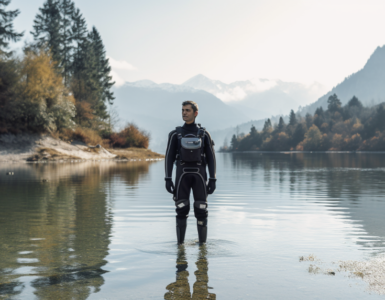When it comes to water sports or any activity on the water, safety should always be the top priority. Among the essential equipment that can ensure your safety, life jackets and Personal Flotation Devices (PFDs) are the most common. These items are not just accessories – they are life-saving tools that have proven their worth time and time again. But what exactly is the difference between a life jacket and a PFD? Let’s find out!
Overview of Life Jackets
Life jackets, as the name implies, are designed to save your life. They are typically used during water sports and boating activities. Life jackets are designed to keep the wearer’s head above water and maintain them on their back, even in situations where they might be unconscious. They are usually brightly colored or have reflective materials to increase visibility.
Most importantly, life jackets are subject to strict regulations. For instance, in many countries, children are required to wear life jackets at all times when on a boat. Adults, too, are encouraged to wear them, especially during water sports activities.
Overview of PFDs
On the other hand, PFDs or Personal Flotation Devices serve a similar but slightly different purpose. While they also provide buoyancy in the water, they may not necessarily turn an unconscious person face-up, unlike life jackets. Nevertheless, they are generally more comfortable and allow for greater movement, making them a favorite for activities like kayaking, paddle boarding, and fishing.
PFDs come in various types, each designed for different water activities and conditions. Just like life jackets, they are also subject to regulations. However, these regulations vary depending on the type of PFD and its intended use.
Key Differences between Life Jackets and PFDs
Is a life jacket just a fancy term for a Personal Flotation Device (PFD) or is there more to it? What makes them different, and why should we care?
Buoyancy
One of the primary differences between a life jacket and a PFD is their buoyancy levels. But what exactly does this mean?
A life jacket, as the name implies, is designed to save your life. It has enough buoyancy to turn most people face up in the water, even if they are unconscious. This is crucial in emergency situations where the wearer might be incapable of swimming or keeping their head above water.
On the other hand, PFDs are not designed to turn an unconscious person face up in the water. Instead, they are built to keep a conscious person afloat. This might make you wonder, why would anyone choose a PFD over a lifejacket then? It’s all about the trade-off between buoyancy and mobility.
Design and Comfort
Let’s talk about design and comfort. Can you guess which one offers more mobility?
You got it! It’s the PFDs. Due to their lower buoyancy, PFDs are generally more comfortable and less bulky than life jackets. This makes them a preferred choice for activities where freedom of movement is essential, like kayaking, sailing, or paddle boarding.
Life jackets, on the other hand, tend to be bulkier due to their higher buoyancy. However, this design is what makes them a lifesaver in critical situations, making them the preferred choice for non-swimmers and children.
| Feature | Life Jacket | PFD |
|---|---|---|
| Buoyancy | High buoyancy, can turn an unconscious person face up | Lower buoyancy, keeps a conscious person afloat |
| Design | Bulkier, designed for safety | Less bulky, designed for comfort and mobility |
| Comfort | May be less comfortable due to bulkiness | Generally more comfortable and allows for better mobility |
| Typical Uses | Recommended for non-swimmers and children | Preferred for activities requiring freedom of movement like kayaking, sailing, paddle boarding |
Choosing Between a Life Jacket and a PFD
So, you’re getting ready for some water activities and you’re not sure whether to go for a life jacket or a personal flotation device (PFD)? Don’t worry, you’re not alone. The choice between the two largely depends on the type of water activity you’re planning to engage in.
For activities where rescue might be slow, such as boating in remote areas, a life jacket would be a more suitable choice due to its higher buoyancy. On the other hand, for activities like kayaking or paddleboarding where comfort and ease of movement are essential, a PFD would be a better fit.
Remember, the key here is to balance safety with comfort. After all, a device that’s uncomfortable to wear is likely to be taken off, defeating its purpose entirely.
Safety Tips When Using a Life Jacket or PFD
No matter which you choose, a life jacket or a PFD, safety should always be your top priority. It’s not enough just to wear them, you need to know how to use them correctly too.
Firstly, always ensure that your device fits you well. It should be snug, but not too tight, allowing you to move freely. Secondly, always fasten all straps and zippers. Unfastened devices can slip off, leaving you unprotected. Lastly, never alter your device. Modifications can compromise its buoyancy and overall functionality.
Here’s a quick rundown of some safety tips to keep in mind:
- Check the fit: Ensure your device is the right size for you. It should be snug, but still allow freedom of movement.
- Fasten all straps and zippers: An unfastened device can easily slip off, leaving you unprotected.
- Don’t alter your device: Modifications can compromise its buoyancy and overall functionality.
- Regularly inspect your device: Look for signs of wear and tear before every use.
- Know how to use it: Familiarize yourself with how to put on and secure your device.
Cleaning and Maintaining your Life Jacket or PFD
So, you’ve got your life jacket or PFD and you’re enjoying your water activities safely. But have you ever stopped to think about how to keep these essential safety devices in top condition? Here’s how!
Firstly, after each use, rinse your gear in fresh water. Salt and chlorine can degrade the materials over time, and rinsing removes these harmful substances. Then, allow your life jacket or PFD to air dry, away from direct sunlight. UV rays can damage the material and decrease their lifespan. Remember, no machine washing or dry cleaning! These processes can harm the buoyancy materials inside.
Storage is equally important. Store your life jacket or PFD in a cool, dry place to prevent the growth of mold and mildew. Avoid storing them in a compressed state as this can damage the buoyancy material. Lastly, never use your safety gear as a kneeling pad or boat fender. These uses can cause unexpected damage.
When to Replace Your Life Jacket or PFD
Just like any safety equipment, your life jacket or PFD won’t last forever. Regular inspection and maintenance will extend its lifespan, but eventually, it will need to be replaced. But when is the right time? Let’s find out!
- Inspect for visible signs of wear and tear. This includes rips, tears, or holes in the fabric. Also, check for frayed straps or broken buckles or zippers.
- Check the buoyancy. A life jacket or PFD that doesn’t float as well as it used to is a sure sign it’s time for a replacement.
- If it’s been through a serious incident, like a heavy fall or collision, it might be damaged beyond the visible. It’s safer to replace it.
- If it’s over 10 years old, consider replacing it. Even with the best care, materials can degrade over time.
Remember, if you’re in doubt, it’s better to be safe than sorry. Replace any life jacket or PFD that you’re not 100% sure is in good working condition.
Wrapping Up
Choosing the right safety gear for your water activities is of utmost importance. But it doesn’t stop there – caring for your life jacket or PFD and knowing when to replace it is equally crucial. After all, your safety depends on it, right?
So, let’s commit to regular inspections and maintenance. And remember, when in doubt, replace! Here’s to safe and enjoyable water adventures!




